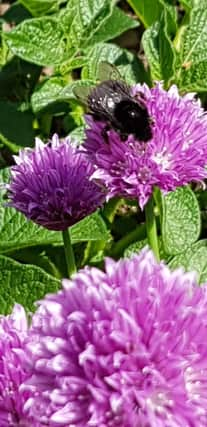GARDENING: It's time to sharpen tools for the Chelsea Chop


The former demands no initial action at all, you simply stand by and observe. The latter involves picking up the secateurs or garden
shears and trimming certain herbaceous perennials just as they`re gearing up to flower. Believe it or not, this can enhance their performance.
Advertisement
Hide AdAdvertisement
Hide AdI`ve been observing our apple trees daily since the first flower buds opened, assessing the level of insect activity which offers an early indication of the potential crop. The weather was reasonable with little wind or rain, bee species were out in force. So, by the time those three days of destructive wind arrived recently, the fruits had formed and stood firm throughout. First hurdle negotiated!
This is the point at which we look objectively at the tiny clusters of fruits, not only on our apple trees but also the pear, plum and cherry, and remind ourselves that to achieve optimum size in maturity they need adequate water, food and space. Given that the first two are offered, we can create space by removing some of the fruits i.e. thinning-out the crop. However, it`s best to hold fire until June has passed because mother nature likes to take the lead in this process.
`Lots of tiny apples have fallen from my tree` is a typical June comment from gardening beginners. `Why?` Truth is, there are various reasons why this occurs. First and foremost is the natural reaction of an organism shedding a percentage of a crop it cannot support through to maturity. If there is a prolonged drought the roots cannot source sufficient water to sustain lots of fruit. This can also happen when a tree is short of carbohydrate because this energy source is the product of photosynthesis, a process that is in turn controlled by weather conditions.
Young fruit trees show a greater loss because of their immaturity, but this recedes with age. Remember, the fewer the fruits, the bigger they become. Good cultivation helps prevent a heavy June loss. I pursue a programme of applying balanced general fertilizer in March followed by organic mulch and watering when necessary throughout the season. It works!
Advertisement
Hide AdAdvertisement
Hide AdThe `Chelsea chop` is a pruning activity centred on herbaceous
perennials. The only connection between it and the famous flower show is the time of year both events take place. But why prune these attractive ornamental plants when they`re making a surge of growth that leads up to flowering?
Circumstances can play a part in the decision to chop or not. For
example, if you have a mixed border in which all the herbaceous plants flower at the same time, say for a month or so, then fade, selective early pruning can help extend the show.
Advertisement
Hide AdAdvertisement
Hide AdBy reducing some of the plants by one third to a half, you are forcing
them to develop more lateral shoots which leads to more flowers. They can take one month or more to form, but that`s often spot on for take over from plants that remained unpruned and bloomed at the normal time. A slightly different approach involves pruning only half of a plant, say, a helianthus, standing 60 centimetres high. Allow the front facing stems to proceed with normal flowering but reduce those facing the back of border by half. Those you pruned will develop unseen then pop into view with fresh flowers as their front counter-parts fade. This works with roses too.
Interested in trying this method? If you`re unsure, experiment with a
single plant whose growth habit you`re familiar with, pruning half the stems and allowing the remainder to develop naturally. Plants that respond to the Chelsea chop include, nepeta, campanula, rudbeckia, helenium, achillea, aster, phlox, echinacea, sedum and penstemon.
Advertisement
Hide AdAdvertisement
Hide AdPenstemon is such a reliable ornamental perennial for continuity of flowering. The earliest blooms are just opening and given reasonable autumn weather will persist deep into November. However, half of the dozen varieties in this garden have had their first CC and others will follow in mid-July. This ensures not only constant flowering but also a stream of stem cuttings that root so easily.
When three days of high winds passed through the garden, they flattened a group of tall blue comfrey (Symphytum caucasicum) that buzzed with bee activity. Pruning to ground level would have seen it re-growing in no time, but we can`t because it was planted for their benefit and they refuse to leave those flowers. But all is not lost, If you prune geraniums, delphiniums, chives and other bee favourites to ground when they`ve run out of steam in summer, there`s a good chance they`ll come back with late blooms!